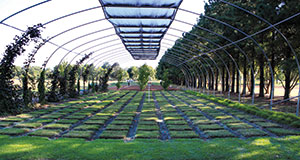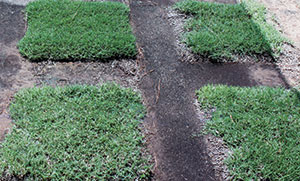Improving shade resistance in bermudagrass
Superintendents know that bermudagrass is an important turfgrass on most golf courses in the South. It has excellent fine-turf characteristics that make it a popular grass for use on fairways, tees, roughs and putting greens. Bermudagrass has relatively good pest resistance, excellent recuperative potential and an aggressive growth habit.
Oklahoma State University (OSU) in cooperation with the United States Golf Association (USGA) and multiple industry partners has successfully released and commercialized cold-tolerant fine-turf bermudagrasses such as Yukon, Riviera and Patriot (Martin et al. 2007; Taliaferro et al., 2004), and most recently, Latitude 36’ and Northbridge. The breeding of improved cold-tolerant bermudagrass cultivars continues at OSU. However, new experimental resources and personnel have led researchers to add improved drought resistance, low irrigation adaptation and shade resistance to their menu of important traits for new bermudagrasses.

Figure 1: The bermudagrass shade study at the Oklahoma State University Turfgrass Research Center, Stillwater, Okla., on September 29, 2009. Photo: Oklahoma State University
In 2009, OSU researchers embarked on a project to screen bermudagrass germplasm for shade resistance. We planted 45 experimental common bermudagrass selections gathered mostly from China, Africa and Australia and four commercially available cultivars — Celebration, Patriot, TifGrand and Tifton 10. The experimental selections were already known to be cold tolerant and good seed producers (Wu et al., 2006). We planted on two sites, one site providing a combination of vegetative and artificial shade, the other providing full sun. The turf was mowed at 2.0 inches to represent golf course rough, irrigated sufficiently to keep all selections green through the growing season, and fertilized at a rate of 1 lb. N per 1,000 sq. ft. per month.
On the shaded site, a combination of mature pines to the west, vines to the east and one (2009) or two (2010 and 2011) 10-ft. wide strips of 75-percent shade cloth overhead provided shade for an average of up to 67 percent of each day, depending on season and year (Fig. 1).
Visual ratings (ratings = 1–9; 9 = best) for turf quality were made for each plot biweekly during 2008, 2009, 2010 and 2011. Turf quality also was rated using a sensor that measured Normalized Difference Vegetation Index (NDVI), an objective measure of turf color and density (Bell et al., 2002; Bell and Xiong, 2008). Visual ratings were used in a comparative fashion to determine the best performing entries in shade and in full sun. Visual ratings and NDVI were used to measure shade resistance by comparing an entry’s mean visual rating or NDVI in shade expressed as a percentage of its mean visual rating or NDVI in full sun [100 x (entry NDVI in full sun minus entry NDVI in shade) divided by entry NDVI in full sun; larger = better].
Shade results
Surprisingly, according to visual ratings, Patriot (mean ratings = 7.1, 7.8, 6.0, and 5.7 in 2008, 2009, 2010 and 2011, respectively) was the top-performing grass in shade for the first three seasons (Fig. 2). Patriot’s strong performance in shade was not expected, since it did not perform exceptionally well in other shade studies (Trappe et al., 2011). Patriot may have superior visual quality in shade, but it also may have been the top performer in this study because it is uniquely adapted to the climate in Stillwater, Okla., where it was developed.
Tifton 10 (mean rating = 6.5) and Celebration (mean rating = 6.5) performed well in shade in 2008; Celebration (7.1), TifGrand (7.0) and Tifton 10 (6.6) in 2009; and Celebration (5.6) and TifGrand (5.6) in 2010. Celebration (6.4) was the top performing cultivar in shade in 2011, with Patriot (5.7) and TifGrand (5.7) close behind. Tifton 10 (5.2) was in the fourth statistical group in 2011. Many of the experimental selections also performed well in shade in at least two of four seasons.

Figure 2: Patriot bermudagrass (upper left corner of photo) outperformed these three seeded experimental entries in shade. However, there were a few seeded experimental entries whose performance was equal to the commercially available cultivars. Photo: Oklahoma State University
Full sun results
According to visual quality ratings, Patriot was the best performing cultivar in full sun for all four seasons (7.7, 8.7, 7.6, and 7.4 in 2008, 2009, 2010, and 2011, respectively). TifGrand also performed well in all four seasons (7.4, 7.8, 7.3, and 6.7). Celebration (7.5, 7.0, and 7.0) and a few of the experimental entries demonstrated excellent performance in the final three seasons.
Shade resistance
By comparing each bermudagrass in full sun with its counterpart in shade, we were able to estimate the shade resistance of each entry. The commercially available cultivars and experimental entries with exceptional fine-turf characteristics ranked high in shade resistance, but rankings differed between visual quality rating and NDVI. According to visual quality, Celebration (-11.3 percent) was the most shade resistant of the commercially available cultivars in the last three years of the study (2009–2010), followed by Tifton 10 (-15.4 percent) and TifGrand (16.0 percent). According to NDVI, TifGrand (-7.9 percent) was the most shade resistant, followed by Celebration (-8.1 percent) and Patriot (-8.4 percent). According to visual quality Patriot (-18.3 percent) had the poorest shade resistance of the commercially available cultivars, and according to NDVI, Tifton 10 (-10.2 percent) was the least shade resistant.
According to NDVI, the shade resistance of five of the experimental entries (-0.2 percent to -14.3 percent, depending on entry and year) was equal to or exceeded the shade resistance of the commercially available cultivars. Of these five experimental entries three also ranked high in shade resistance measured by visual rating. A few of the experimental entries demonstrated good shade resistance but had less than acceptable fine-turf qualities.
In 2012, we selected the best of the experimental entries for fine-turf qualities and shade resistance, followed by more crossing, which resulted in promising experimental seed-propagated lines that are undergoing additional investigation for shade tolerance and specific trait evaluation over the next several years.
We expect that the resultant progeny will demonstrate superior turf performance in internal as well as external testing, such as in the National Turfgrass Evaluation Program (NTEP). Excellent fine-turf characteristics, coupled with good seed yields, should allow the eventual release and commercialization of seeded bermudagrasses with improved shade resistance in the next few years.
Acknowledgments
The authors would like to thank the United States Golf Association for their financial support of this project. Additional funds were provided by the Oklahoma Agricultural Experiment Station.
Gregory E. Bell, Ph.D., Yanqi Wu, Ph.D., Dennis L. Martin, Ph.D., Justin Q. Moss, Ph.D., and Kyungjoon Koh, M.S. are turfgrass scientists at Oklahoma State University. Bell can be reached at greg.bell@okstate.edu.
References
Bell, G.E., D.L. Martin, M.L. Stone, J.B. Solie, and G.V. Johnson. 2002. Turf area mapping using vehicle-mounted optical sensors. Crop Sci. 42:648-651.
Bell, G.E. and X. Xiong. 2008. The history, role, and potential of optical sensing for practical turf management. p. 641-658. M. Pessarakli (ed.) Handbook of turfgrass management and physiology. CRC Press, Boca Raton, FL.
Martin, D.L., Y. Wu, J.A. Anderson, M.P. Anderson, G.E. Bell and N.R. Walker. 2007. Bermudagrass Cultivars with High Quality and Improved Cold Hardiness. USGA Turfgrass and Environmental Research Online 6(17):1-8. Available at: http://usgatero.msu.edu/
Taliaferro, C.M., D.L. Martin, J.A. Anderson, M.P. Anderson, and A.C. Guenzi. 2004. Broadening the horizons of turf bermudagrass. USGA Turfgrass and Environmental Research Online. 3(20):1-9. Available at: http://usgatero.msu.edu/
Trappe, J.M., D.E. Karcher, M.D. Richardson, and A.J. Patton. 2011. Shade and traffic tolerance varies for bermudagrass and zoysiagrass cultivars. Crop Sci. 51:870-877.
Wu, Y.Q., C.M. Taliaferro, D.L. Martin, C.L. Goad, and J.A. Anderson. 2006. Genetic variability and relationships for seed yield and its components in Chinese Cynodon accessions. Field Crop Res. 98: 245-252.








